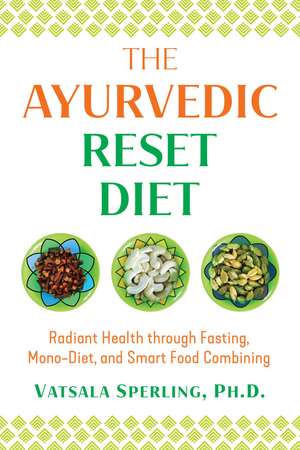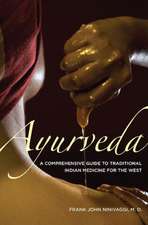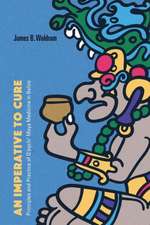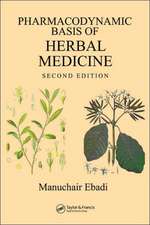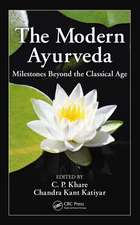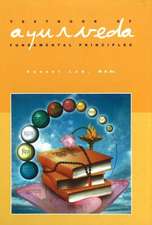The Ayurvedic Reset Diet: Radiant Health through Fasting, Mono-Diet, and Smart Food Combining
Autor Vatsala Sperlingen Limba Engleză Paperback – 17 mar 2021
• Presents easy-to-follow instructions for a full 6- or 8-week Ayurvedic rest diet, as well as a simplified 1-week plan, detailing what to eat and drink day by day
• Includes recipes, mindful eating tips, and meal prepping techniques
• Explains the healing science of Ayurveda, the rejuvenating benefits of fasting and mono-diets, and how to maximize nutrient absorption with food combining
Food sensitivities, chronic inflammation, obesity, and chronic disease are on the rise. Could our modern diets and mindless eating habits be to blame? How do you reboot your system--body, mind, and spirit--and start the path to radiant health?
In this easy-to-follow guide to Ayurvedic dietary resets, Vatsala Sperling, Ph.D., details how to rest and gently cleanse your digestive system, lose extra pounds, and reboot your body and mind with the Ayurvedic techniques of fasting, mono-diets, and food combining. She begins by sharing a simplified introduction to the healing science of Ayurveda from India and explains the spiritual, mindful relationship to food at its heart. Offering step-by-step instructions for a full 6- or 8-week Ayurvedic reset diet, as well as a simplified 1-week program, she details, day by day, what to eat and drink and provides recipes and meal prepping tips and techniques.
The author explains how to prepare for fasting and the benefits of giving your digestive system a break from food, even if only for one day. She prepares you for mono-dieting--when you eat one type of food such as fruits or vegetables for a set period--and reveals the rejuvenating effects that come from isolating your daily diet to one food type. The author then explores the Ayurvedic techniques of food combining in detail, explaining exactly what to eat when to maximize nutrient absorption.
Based on the ancient wisdom of Ayurveda, this guide provides everything you need to know to heal your digestive system, prevent chronic ailments, find your healthy weight, and rebuild your sacred relationship with food.
Preț: 88.05 lei
Nou
Puncte Express: 132
Preț estimativ în valută:
16.85€ • 17.53$ • 14.12£
16.85€ • 17.53$ • 14.12£
Carte disponibilă
Livrare economică 20 februarie-06 martie
Livrare express 05-11 februarie pentru 20.25 lei
Preluare comenzi: 021 569.72.76
Specificații
ISBN-13: 9781644111307
ISBN-10: 1644111306
Pagini: 160
Ilustrații: 6 b&w illustrations
Dimensiuni: 152 x 229 x 10 mm
Greutate: 0.25 kg
Editura: Inner Traditions/Bear & Company
Colecția Healing Arts Press
ISBN-10: 1644111306
Pagini: 160
Ilustrații: 6 b&w illustrations
Dimensiuni: 152 x 229 x 10 mm
Greutate: 0.25 kg
Editura: Inner Traditions/Bear & Company
Colecția Healing Arts Press
Notă biografică
Vatsala Sperling, Ph.D., PDHom, CCH, RSHom, is a classical homeopath who grew up in India and earned her doctorate in clinical microbiology. Before moving to the United States in the 1990s, she was the Chief of Clinical Microbiology at the Childs Trust Hospital in Chennai, India, where she published extensively and conducted research with the World Health Organization. A founding member of Hacienda Rio Cote, a reforestation project in Costa Rica, she runs her own homeopathy practice in both Vermont and Costa Rica. She lives in Rochester, Vermont.
Extras
Step 1: Fasting Week
1, Day 1: Fasting on Room Temperature or Warm Water Only
The first two days of the Ayurvedic Isolation Diet are the days of fasting. This means you are not going to eat any solids.
On day 1, you will drink only water. You can have warm water or have it at room temperature. But avoid drinking ice cold water with ice floating in it. If you want, you can squeeze a slice of lemon into the water. Do not add sugar, salt, or honey.
Drink a cup of water every hour. You will be peeing a lot but that is ok. As you begin to drink water, slow down a bit. There is no rush. Hold the water in your mouth for a little while. Savor its taste. Move it around. After all, water is the most important ingredient of your food and also your body. It keeps you alive just like air does. Why be in a hurry when you drink water? Drink it slowly, mindfully, as if it is divine nectar.
Week 1, Day 2: Fasting on Water Alternating with Herbal Teas
Drink a cup of herbal tea alternating with a cup of plain water -- again, one drink every hour. You can make organic herbal teas, add a squeeze of lemon, and a teaspoon of honey if you like. You may not have a bowel movement on this day as you have not eaten anything the day before. But if you have not had a bowel movement since starting your day 1 of water intake and day 2 of water and herbal tea intake, now your bowels might want to clear themselves out and evacuate the old feces. Honey and plenty of water provide the energy and pressure necessary to create a bowel movement.
A note about organic, raw, local honey: There are studies that support the view that even type 2 diabetics can eat local, raw, and organic honey. They might experience a reduction in body weight, blood lipids, as well as glucose (53D).
Someone might prefer just extending the water-only fast to day 2 and not bother with herbal teas. That is quite fine too. However, herbal teas with some honey added provide a slight amount of energy, satisfy the need for warm/hot drinks, increase the metabolism in the body, and also break the monotony of just having to drink water for two days in a row. Day 2 of fasting is very important because when the gastrointestinal and excretory system is not constantly dealing with incoming foods and metabolites, these systems not only get cleaned but also get a chance to repair their cells and tissues.
What about caffeine?
During fasting days, when you drink water only or herbal teas alternating with water, you will come to know if you are addicted to caffeine or not. Caffeine addiction shows itself as withdrawal headache, fatigue, anxiety, irritability, low energy, depressed mood, listlessness, jitteriness, and lethargy when you miss drinking your daily tea/coffee at the time when you are used to drinking it. Breaking this habit in one day can be problematic, and of course this experience is not worth it.
As you begin your water only fast, make sure your caffeine supply is available, at least the first cup of tea or coffee that you drink first thing in the morning. When you feel the first stirrings of withdrawal symptoms, first fill up your stomach with water and only then drink your tea or coffee so that these beverages do not bother and irritate your empty stomach.
Step 2: Ayurvedic Isolation Diet or Mono-Diet on Vegetables Only
Week 1, Days 3-7
Days 3 through 7 are when you are going to focus on eating one type of food at a time (mono-diet).
Since you are eating just one type of food, there will be a little inner voice asking for other food groups. Though you are eating just one type of food (vegetables), you are eating sufficient quantities of it till your hunger is satisfied. You are not depriving yourself or starving. As a result, you will not be extremely hungry and thus you will have better chance of staying on the plan and bringing it to a successful conclusion.
The best guide for knowing how much to eat is your own hunger. Eat enough vegetables to fill your stomach. You do not have to starve yourself while you are practicing the Ayurvedic isolation diet, and there is no need to overeat at any given meal either, because you can always have a vegetable snack between meals.
Eat Just One Type of Vegetable for Each Meal
In therapeutic applications of the Ayurvedic isolation diet, people have obtained brilliant results by eating just one type of vegetable for over two weeks, for all meals and snacks. For the best curative outcomes, it is best to stick with this recommendation. However, for the general purposes of cleansing, regeneration, rejuvenation, and weight loss, it is okay to eat different vegetables each day, but not in the same meal. So, on Week 1 of vegetables only, you would eat only one type of vegetable--broccoli, for example, for breakfast, then another type, say, carrots for the lunch, and so on. This allows the digestive system to fully extract all the nutrients from that one type of vegetable and then focus its attention on extracting nutrients from reserved fats and unwanted tissues in the body before the next meal.
1, Day 1: Fasting on Room Temperature or Warm Water Only
The first two days of the Ayurvedic Isolation Diet are the days of fasting. This means you are not going to eat any solids.
On day 1, you will drink only water. You can have warm water or have it at room temperature. But avoid drinking ice cold water with ice floating in it. If you want, you can squeeze a slice of lemon into the water. Do not add sugar, salt, or honey.
Drink a cup of water every hour. You will be peeing a lot but that is ok. As you begin to drink water, slow down a bit. There is no rush. Hold the water in your mouth for a little while. Savor its taste. Move it around. After all, water is the most important ingredient of your food and also your body. It keeps you alive just like air does. Why be in a hurry when you drink water? Drink it slowly, mindfully, as if it is divine nectar.
Week 1, Day 2: Fasting on Water Alternating with Herbal Teas
Drink a cup of herbal tea alternating with a cup of plain water -- again, one drink every hour. You can make organic herbal teas, add a squeeze of lemon, and a teaspoon of honey if you like. You may not have a bowel movement on this day as you have not eaten anything the day before. But if you have not had a bowel movement since starting your day 1 of water intake and day 2 of water and herbal tea intake, now your bowels might want to clear themselves out and evacuate the old feces. Honey and plenty of water provide the energy and pressure necessary to create a bowel movement.
A note about organic, raw, local honey: There are studies that support the view that even type 2 diabetics can eat local, raw, and organic honey. They might experience a reduction in body weight, blood lipids, as well as glucose (53D).
Someone might prefer just extending the water-only fast to day 2 and not bother with herbal teas. That is quite fine too. However, herbal teas with some honey added provide a slight amount of energy, satisfy the need for warm/hot drinks, increase the metabolism in the body, and also break the monotony of just having to drink water for two days in a row. Day 2 of fasting is very important because when the gastrointestinal and excretory system is not constantly dealing with incoming foods and metabolites, these systems not only get cleaned but also get a chance to repair their cells and tissues.
What about caffeine?
During fasting days, when you drink water only or herbal teas alternating with water, you will come to know if you are addicted to caffeine or not. Caffeine addiction shows itself as withdrawal headache, fatigue, anxiety, irritability, low energy, depressed mood, listlessness, jitteriness, and lethargy when you miss drinking your daily tea/coffee at the time when you are used to drinking it. Breaking this habit in one day can be problematic, and of course this experience is not worth it.
As you begin your water only fast, make sure your caffeine supply is available, at least the first cup of tea or coffee that you drink first thing in the morning. When you feel the first stirrings of withdrawal symptoms, first fill up your stomach with water and only then drink your tea or coffee so that these beverages do not bother and irritate your empty stomach.
Step 2: Ayurvedic Isolation Diet or Mono-Diet on Vegetables Only
Week 1, Days 3-7
Days 3 through 7 are when you are going to focus on eating one type of food at a time (mono-diet).
Since you are eating just one type of food, there will be a little inner voice asking for other food groups. Though you are eating just one type of food (vegetables), you are eating sufficient quantities of it till your hunger is satisfied. You are not depriving yourself or starving. As a result, you will not be extremely hungry and thus you will have better chance of staying on the plan and bringing it to a successful conclusion.
The best guide for knowing how much to eat is your own hunger. Eat enough vegetables to fill your stomach. You do not have to starve yourself while you are practicing the Ayurvedic isolation diet, and there is no need to overeat at any given meal either, because you can always have a vegetable snack between meals.
Eat Just One Type of Vegetable for Each Meal
In therapeutic applications of the Ayurvedic isolation diet, people have obtained brilliant results by eating just one type of vegetable for over two weeks, for all meals and snacks. For the best curative outcomes, it is best to stick with this recommendation. However, for the general purposes of cleansing, regeneration, rejuvenation, and weight loss, it is okay to eat different vegetables each day, but not in the same meal. So, on Week 1 of vegetables only, you would eat only one type of vegetable--broccoli, for example, for breakfast, then another type, say, carrots for the lunch, and so on. This allows the digestive system to fully extract all the nutrients from that one type of vegetable and then focus its attention on extracting nutrients from reserved fats and unwanted tissues in the body before the next meal.
Cuprins
Acknowledgments
Introduction: Food as Friend or Foe?
An Ayurvedic Perspective
1 A Season for Everything: The Way Our Ancestors Ate
2 The New Normal: Loss of Seasonality and Quality in Modern Eating
3 Industrial Food Production: Technology for Taming and Manipulating Nature
4 Principles of the Ayurvedic Reset Diet: How to Reboot Well-Being
5 Preparing for the Ayurvedic Reset Diet: Actions to Take before You Begin
6 The Ayurvedic Reset Diet: Eight-, Six-, and One-Week Protocols
7 Daily Living: Benefits, Challenges, and Next Steps
Notes
Index
Introduction: Food as Friend or Foe?
An Ayurvedic Perspective
1 A Season for Everything: The Way Our Ancestors Ate
2 The New Normal: Loss of Seasonality and Quality in Modern Eating
3 Industrial Food Production: Technology for Taming and Manipulating Nature
4 Principles of the Ayurvedic Reset Diet: How to Reboot Well-Being
5 Preparing for the Ayurvedic Reset Diet: Actions to Take before You Begin
6 The Ayurvedic Reset Diet: Eight-, Six-, and One-Week Protocols
7 Daily Living: Benefits, Challenges, and Next Steps
Notes
Index
Recenzii
“In this timely book, Vatsala Sperling takes us back to a preindustrial age when we lived according to the cycles of nature and shows us that it is once again possible to restore vibrant and radiant health by following the practices outlined in this lovely book. This should be required reading for anyone interested in Ayurvedic dietary principles and lifestyle.”
“Vatsala Sperling has gathered a lifetime of cultural influence, serious study, and daily practice into this book. I have sat at Vatsala’s table and eaten her food. She knows how to create a life-affirming, healthy, peaceful oasis and offers wisdom and guidance on how to accomplish exactly that. Ayurveda means ‘science of life.’ In this remarkably thorough work, Vatsala provides all the knowledge required to bring life into your kitchen and your home. This is beautiful stuff.”
“In Ayurvedic Reset Diet Vatsala Sperling presents practical tools and authentic Ayurvedic guidance with precision and insight. The book is replete with practical methods that one can integrate into everyday life with ease to achieve better health and wellness.”
“The Ayurvedic Reset Diet is an easy-to-read guide to using basic Ayurvedic principles to achieve health. Most people, especially in the West, have been conditioned to eating in ways that actually rob them of vibrant health and often lead to illness. This book offers a way out of that routine. Vatsala explains very clearly how and why to follow simple dietary guidelines to recover health in a very down-to-earth way. By explaining the rationale for the guidelines, the author makes it even easier to apply them. This is one of those books that can make a big difference for anyone motivated to achieve better health. I recommend it highly.”
“I have met many doctors--allopathic, Ayurvedic, and naturopathic--and the best have one thing in common: they were raised by healers. They grew up in a living tradition, imbibing everyday wisdom from a parent or grandparent. Vatsala falls into this category and seamlessly combines her medical knowledge with traditional know-how. For those of us who didn’t have the good fortune to be raised in such an environment, this book provides the next best thing.”
"Sperling’s knowledge of the Ayurvedic diet is amazing. She was raised in this tradition as she grew up in India. She has a doctorate in microbiology and has conducted research with the World Health Organization. Impressive credentials, for sure, but what I most liked about Sperling was her writing style and her passion to impart this ancient way of being to others. I highly recommend The Ayurvedic Reset Diet, even if you’re not sure this is the right diet path. It is an eye-opener and life-changer in regard to how, why, and when we choose to eat."
“This simple guide to an Ayurvedic diet details how to properly choose, prepare, and combine food. The first two chapters point out many disadvantages of dining on fast and industrialized food and of overeating. It explains how to cleanse the body and then transition from bad eating habits into a simple diet of seasonal and locally available foods. The one, six, or eight week reset diet shows the reader how to do this. Various types of cleansing and water fasts are explained along with ideas on which one to choose.”
“Vatsala Sperling has gathered a lifetime of cultural influence, serious study, and daily practice into this book. I have sat at Vatsala’s table and eaten her food. She knows how to create a life-affirming, healthy, peaceful oasis and offers wisdom and guidance on how to accomplish exactly that. Ayurveda means ‘science of life.’ In this remarkably thorough work, Vatsala provides all the knowledge required to bring life into your kitchen and your home. This is beautiful stuff.”
“In Ayurvedic Reset Diet Vatsala Sperling presents practical tools and authentic Ayurvedic guidance with precision and insight. The book is replete with practical methods that one can integrate into everyday life with ease to achieve better health and wellness.”
“The Ayurvedic Reset Diet is an easy-to-read guide to using basic Ayurvedic principles to achieve health. Most people, especially in the West, have been conditioned to eating in ways that actually rob them of vibrant health and often lead to illness. This book offers a way out of that routine. Vatsala explains very clearly how and why to follow simple dietary guidelines to recover health in a very down-to-earth way. By explaining the rationale for the guidelines, the author makes it even easier to apply them. This is one of those books that can make a big difference for anyone motivated to achieve better health. I recommend it highly.”
“I have met many doctors--allopathic, Ayurvedic, and naturopathic--and the best have one thing in common: they were raised by healers. They grew up in a living tradition, imbibing everyday wisdom from a parent or grandparent. Vatsala falls into this category and seamlessly combines her medical knowledge with traditional know-how. For those of us who didn’t have the good fortune to be raised in such an environment, this book provides the next best thing.”
"Sperling’s knowledge of the Ayurvedic diet is amazing. She was raised in this tradition as she grew up in India. She has a doctorate in microbiology and has conducted research with the World Health Organization. Impressive credentials, for sure, but what I most liked about Sperling was her writing style and her passion to impart this ancient way of being to others. I highly recommend The Ayurvedic Reset Diet, even if you’re not sure this is the right diet path. It is an eye-opener and life-changer in regard to how, why, and when we choose to eat."
“This simple guide to an Ayurvedic diet details how to properly choose, prepare, and combine food. The first two chapters point out many disadvantages of dining on fast and industrialized food and of overeating. It explains how to cleanse the body and then transition from bad eating habits into a simple diet of seasonal and locally available foods. The one, six, or eight week reset diet shows the reader how to do this. Various types of cleansing and water fasts are explained along with ideas on which one to choose.”
Descriere
A step-by-step guide to Ayurvedic dietary resets to gently cleanse your digestive system and reboot your body and mind.
